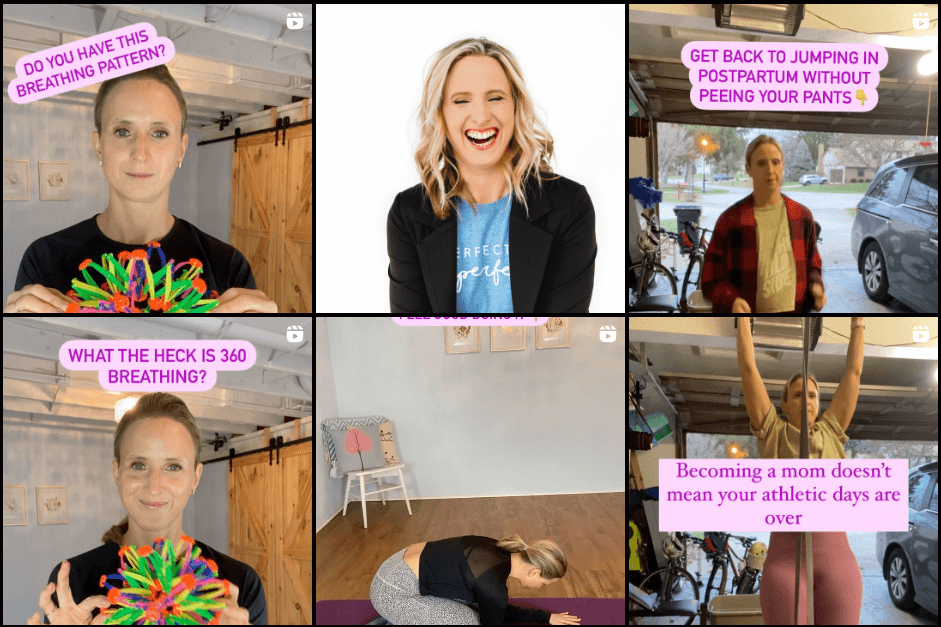Why didn’t anyone tell me about how my pelvic floor would feel after birth? Why didn’t anyone tell me peeing my pants every time I look at the toilet should not be the norm? How did I not know of postpartum exercises to strengthen my weakened pelvic core? Why didn’t anyone tell me I should rehab my core and pelvic floor BEFORE returning to my regular activities to avoid setbacks?
These were my thoughts after the birth of our second child. I felt betrayed by our medical system. They didn’t warn me that giving birth could bring on some core and pelvic floor issues if not addressed right away. It is literally something no one had talked to me about. I had to bring up my concerns with my care provider and I honestly think they would have never asked if I didn’t mention my bladder issues.
COMMON POSTPARTUM HEALTH ISSUES
It can feel so isolating to be experiencing leaking urine after birth. Even though pelvic floor dysfunctions (stress and urgency incontinence, pelvic organ prolapse etc.) or aches and pains are common in postpartum, they should not be the norm.
The weeks following birth are setting the stage for a woman’s long-term health and well-being. During this critical time, a woman will go through an enormous amount of changes. From physical to psychological and social changes. Besides that, she will have to learn how to care for her baby, heal from childbirth, and deal with sleep deprivation just to name a few.
Motherhood is such an important transition in a woman’s life. We need to bring more education and awareness around taking care of our mental AND physical health especially postpartum exercises.
POSTPARTUM EXERCISESi.e REHAB SHOULD BE STANDARD
Being given the green light at 6 weeks doesn’t mean you should automatically jump back into the exercises you were doing before baby. In fact, there are so many considerations to look at. No matter how your birth went or what type of birth you had, I believe every woman can benefit from starting with a rehab program in postpartum.
It makes sense to first work on building a strong foundation, healing, and strengthening your core and pelvic floor. Afterward, you can tackle more challenging activities. Reconnecting with your body will not only help you heal physically and mentally but also help you avoid setbacks down the road.

Women need more support and guidance in early postpartum exercises. They need much more than a short visit 6 weeks post birth giving them the green light to exercise and have sex. How about we work on building a strong foundation? Why not address issues like leaking urine, pelvic pain or diastasis recti right away? Or work on getting the body well supported and free of aches and pains?
THE FIRST STEPS IN POSTPARTUM EXERCISES FOR REHAB
Once you have rested and bonded with your baby, you should start by purposely reconnecting with your body. I am talking about the deeper layers that make up for a strong foundation: your diaphragm, your deep abdominals, and your pelvic floor. Spending time reconnecting with these muscles is CRUCIAL in postpartum!

The goal should be to heal the body from the inside out to regain optimal function of the body. After you have rebuilt a strong functional foundation only then can you go back to the activities you love with a body that can handle it without major setbacks or injuries.
My 3 FAVORITE POSTPARTUM EXERCISES TO STRENGTHEN YOUR CORE
The following postpartum exercises are some of my favorites to help moms rehab their core and pelvic floor after birth. However, they are not the first core rehab exercises you should be doing in early postpartum. Keep in mind that mastering diaphragmatic breathing, pelvic floor contraction, and relaxation, and deep abdominal connection should be done first. The Fourth Trimester Restore is perfect for early postpartum mamas to restore their core and pelvic floor after birth!
The key to strengthening the inner core in postpartum is to slowly and progressively add more challenging movements. For Instance, do these while making sure the person is connecting to their pelvic floor and deep abdominal muscles. Actually, I like to start my mamas with exercises lying supine and then progress to standing (this might take weeks of progression).
Of course, always check with your doctor before starting an exercise program.
1. Dead Bug With Ball
- Lay on your back with your knees bent at a 90 degree angle. Keep your ribs down toward the floor as you do this exercise.
- Place a stability ball between your knees and elbows. Press on the ball with both your knees and elbows to engage your core.
- Take a diaphragmatic breath in, feeling your ribs expand outward and your belly naturally filling with air.
- Start exhaling as you gently lift and squeeze your pelvic floor and engage your deep abdominals. Keep exhaling as you maintain these engagements, and slowly lower your opposite hand and heel to the floor.
- Your opposite elbow and knee should maintain pressure on the ball while you lower your other limbs.
- Keep exhaling as you bring your hand and heel back up to the ball.
- Repeat 10 times, alternating sides, making sure your ribs are down and that you are maintaining good core connection breath.
2. Glute Bridge With Ball Squeeze

- Start by lying on your back with your knees bent and place a ball (a child’s ball will work fine) between your knees.
- Take a diaphragmatic breath in, feeling your ribs expand outward and your belly naturally filling up with air.
- Start exhaling as you gently lift and squeeze your pelvic floor and engage your deep abdominals. Keep exhaling as you maintain these engagements. Squeeze the ball with your knees, and raise your hips up until you reach a straight line from your shoulders to your knees.
- Your glutes should be activated as you move into your bridge.
- Slowly bring your hips back toward the ground and release the tension on the ball as you take a nice diaphragmatic breath in.
- Repeat 10 times with slow and controlled movements focussing on core and breath connection.
3. Half Kneeling Pallof Press
- Anchor a resistance band securely at chest height while in a kneeling position.
- In a tall half kneeling position, hold the resistance band at your chest and take a diaphragmatic breath in. Make sure to feel your ribs expand outward and your belly naturally filling up with air.
- Start exhaling as you gently lift and squeeze your pelvic floor and engage your deep abdominals. Keep exhaling as you slowly (to a count of 3) press the resistance band straight out in front of you.
- Make sure you are keeping a nice tall posture with your ribs down and resist the urge to rotate your body.
- Inhale again filling your belly naturally with air as you slowly (to a count of 3) bring the resistance band back to the starting position.
- Repeat 10 times with slow and controlled movements and good core connection breath.
If you have any questions, please reach out to me here. I love to hear from you! I also have a Free Postpartum Regain Strength Guide to get you started on strengthening your core. Check it out!



